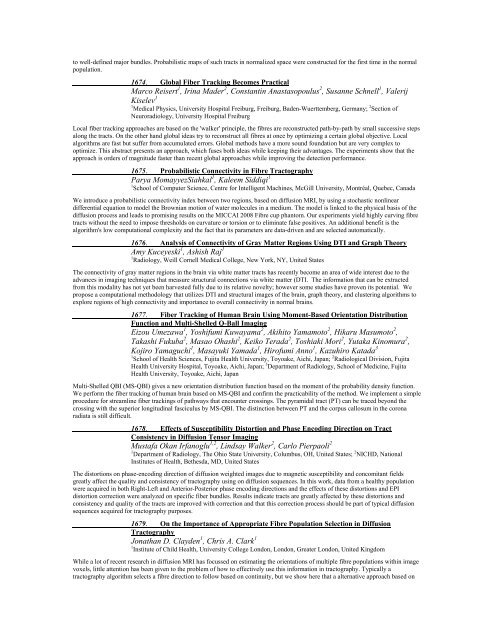Traditional Posters: Diffusion & Perfusion - ismrm
Traditional Posters: Diffusion & Perfusion - ismrm
Traditional Posters: Diffusion & Perfusion - ismrm
You also want an ePaper? Increase the reach of your titles
YUMPU automatically turns print PDFs into web optimized ePapers that Google loves.
to well-defined major bundles. Probabilistic maps of such tracts in normalized space were constructed for the first time in the normal<br />
population.<br />
1674. Global Fiber Tracking Becomes Practical<br />
Marco Reisert 1 , Irina Mader 2 , Constantin Anastasopoulus 2 , Susanne Schnell 1 , Valerij<br />
Kiselev 1<br />
1 Medical Physics, University Hospital Freiburg, Freiburg, Baden-Wuerttemberg, Germany; 2 Section of<br />
Neuroradiology, University Hospital Freiburg<br />
Local fiber tracking approaches are based on the 'walker' principle, the fibres are reconstructed path-by-path by small successive steps<br />
along the tracts. On the other hand global ideas try to reconstruct all fibres at once by optimizing a certain global objective. Local<br />
algorithms are fast but suffer from accumulated errors. Global methods have a more sound foundation but are very complex to<br />
optimize. This abstract presents an approach, which fuses both ideas while keeping their advantages. The experiments show that the<br />
approach is orders of magnitude faster than recent global approaches while improving the detection performance.<br />
1675. Probabilistic Connectivity in Fibre Tractography<br />
Parya MomayyezSiahkal 1 , Kaleem Siddiqi 1<br />
1 School of Computer Science, Centre for Intelligent Machines, McGill University, Montréal, Quebec, Canada<br />
We introduce a probabilistic connectivity index between two regions, based on diffusion MRI, by using a stochastic nonlinear<br />
differential equation to model the Brownian motion of water molecules in a medium. The model is linked to the physical basis of the<br />
diffusion process and leads to promising results on the MICCAI 2008 Fibre cup phantom. Our experiments yield highly curving fibre<br />
tracts without the need to impose thresholds on curvature or torsion or to eliminate false positives. An additional benefit is the<br />
algorithm's low computational complexity and the fact that its parameters are data-driven and are selected automatically.<br />
1676. Analysis of Connectivity of Gray Matter Regions Using DTI and Graph Theory<br />
Amy Kuceyeski 1 , Ashish Raj 1<br />
1 Radiology, Weill Cornell Medical College, New York, NY, United States<br />
The connectivity of gray matter regions in the brain via white matter tracts has recently become an area of wide interest due to the<br />
advances in imaging techniques that measure structural connections via white matter (DTI. The information that can be extracted<br />
from this modality has not yet been harvested fully due to its relative novelty; however some studies have proven its potential. We<br />
propose a computational methodology that utilizes DTI and structural images of the brain, graph theory, and clustering algorithms to<br />
explore regions of high connectivity and importance to overall connectivity in normal brains.<br />
1677. Fiber Tracking of Human Brain Using Moment-Based Orientation Distribution<br />
Function and Multi-Shelled Q-Ball Imaging<br />
Eizou Umezawa 1 , Yoshifumi Kuwayama 2 , Akihito Yamamoto 2 , Hikaru Masumoto 2 ,<br />
Takashi Fukuba 2 , Masao Ohashi 2 , Keiko Terada 2 , Toshiaki Mori 2 , Yutaka Kinomura 2 ,<br />
Kojiro Yamaguchi 1 , Masayuki Yamada 1 , Hirofumi Anno 1 , Kazuhiro Katada 3<br />
1 School of Health Sciences, Fujita Health University, Toyoake, Aichi, Japan; 2 Radiological Division, Fujita<br />
Health University Hospital, Toyoake, Aichi, Japan; 3 Department of Radiology, School of Medicine, Fujita<br />
Health University, Toyoake, Aichi, Japan<br />
Multi-Shelled QBI (MS-QBI) gives a new orientation distribution function based on the moment of the probability density function.<br />
We perform the fiber tracking of human brain based on MS-QBI and confirm the practicability of the method. We implement a simple<br />
procedure for streamline fiber trackings of pathways that encounter crossings. The pyramidal tract (PT) can be traced beyond the<br />
crossing with the superior longitudinal fasciculus by MS-QBI. The distinction between PT and the corpus callosum in the corona<br />
radiata is still difficult.<br />
1678. Effects of Susceptibility Distortion and Phase Encoding Direction on Tract<br />
Consistency in <strong>Diffusion</strong> Tensor Imaging<br />
Mustafa Okan Irfanoglu 1,2 , Lindsay Walker 2 , Carlo Pierpaoli 2<br />
1 Department of Radiology, The Ohio State University, Columbus, OH, United States; 2 NICHD, National<br />
Institutes of Health, Bethesda, MD, United States<br />
The distortions on phase-encoding direction of diffusion weighted images due to magnetic susceptibility and concomitant fields<br />
greatly affect the quality and consistency of tractography using on diffusion sequences. In this work, data from a healthy population<br />
were acquired in both Right-Left and Anterior-Posterior phase encoding directions and the effects of these distortions and EPI<br />
distortion correction were analyzed on specific fiber bundles. Results indicate tracts are greatly affected by these distortions and<br />
consistency and quality of the tracts are improved with correction and that this correction process should be part of typical diffusion<br />
sequences acquired for tractography purposes.<br />
1679. On the Importance of Appropriate Fibre Population Selection in <strong>Diffusion</strong><br />
Tractography<br />
Jonathan D. Clayden 1 , Chris A. Clark 1<br />
1 Institute of Child Health, University College London, London, Greater London, United Kingdom<br />
While a lot of recent research in diffusion MRI has focussed on estimating the orientations of multiple fibre populations within image<br />
voxels, little attention has been given to the problem of how to effectively use this information in tractography. Typically a<br />
tractography algorithm selects a fibre direction to follow based on continuity, but we show here that a alternative approach based on















